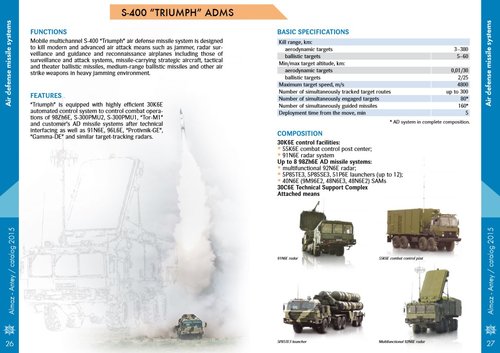I could be wrong but if I understand it correctly, isn't SM-3 only reach Mach 10 exoatmosphere?Don't be so sure, an SM-3 has the same booster and reaches 3km/s, which is about Mach 10 at altitude.
You are using an out of date browser. It may not display this or other websites correctly.
You should upgrade or use an alternative browser.
You should upgrade or use an alternative browser.
Almaz-Antey S-400 Triumph / SA-21 Growler TABM/SAM
- Thread starter Woody
- Start date
isn't SM-3 only reach Mach 10 exoatmosphere?
I honestly don't know for sureisn't SM-3 only reach Mach 10 exoatmosphere?
Forest Green
ACCESS: Above Top Secret
- Joined
- 11 June 2019
- Messages
- 9,412
- Reaction score
- 17,142
I don't know where burnout is but there really isn't much air above 20km.I could be wrong but if I understand it correctly, isn't SM-3 only reach Mach 10 exoatmosphere?
Forest Green
ACCESS: Above Top Secret
- Joined
- 11 June 2019
- Messages
- 9,412
- Reaction score
- 17,142
Yes, I remember that. The closing speed was 9.8km/s and, as you say, it definitely wasn't nose-to-nose because the satellite was on a decaying orbit, hence why it was shot down."On February 21, 03:26 GMT an SM-3 missile was fired from the Ticonderoga-class missile cruiser USS Lake Erie and intercepted USA-193 about 133 nautical miles (247 kilometers)[25] above the Pacific Ocean. The satellite was traveling with a velocity of about 17,500 mph (around 28,000 km/h, or 7.8 km/s). The velocity of the impact was about 22,000 mph. "
Flight time was 166 seconds. That gives an AVERAGE vertical velocity component of about Mach 5. The missile contributed 4,500 mph to the combined impact velocity. As it wasn't a nose-to-nose impact the missiles speed at impact was likely much higher.
Skeptical About the Rogue Spy Sat 'Shot'
The ‘shot‘ — that’s what Ambassador James Jeffrey called the decision to use an an Aegis SM-3 to try to shoot down satellite USA 193 in the next 3-12 days. Holding the aside the politics of this — which are terrible — the briefing on debris risk left me cold. I have to say that […]
There is enough for jet engine to operateI don't know where burnout is but there really isn't much air above 20km.
Forest Green
ACCESS: Above Top Secret
- Joined
- 11 June 2019
- Messages
- 9,412
- Reaction score
- 17,142
Well yeah, but definitely not enough for you to breath, that limit is about 8km. It's >15x less that at sea level and, as you can see, at 30km it's >100 times less than at sea level, and hence drag is >100x less. So whilst the official line between the atmosphere and space is 100km, it gets very space-like well before that and spy satellites running elliptical orbits have perigees as low as 80km.There is enough for jet engine to operate

The edge of space: Revisiting the Karman Line
In this paper I revisit proposed definitions of the boundary between the Earth's atmosphere and outer space, considering orbital and suborbital trajec…
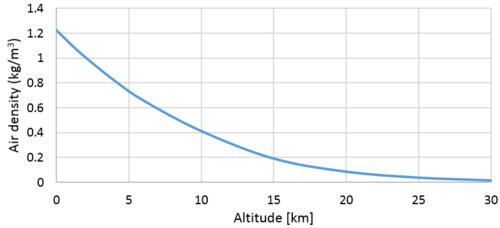
Last edited:
I know drag at high altitude is lower due to lower air density. But drag at high speed is exponentially higher than low speed. Drag at Mach 10 is 100 times higher than at Mach 1. So I think drag is still a big factor. In addition, 40N6E and 48N6E2 are a lot bigger than SM-6, so I think it is logical that their booster are more powerful and can propell them to higher speed.Well yeah, but definitely not enough for you to breath, that limit is about 8km. It's >15x less that at sea level and, as you can see, at 30km it's >100 times less than at sea level, and hence drag is >100x less. So whilst the official line between the atmosphere and space is 100km, it gets very space-like well before that and spy satellites running elliptical orbits have perigees as low as 80km.There is enough for jet engine to operate
View attachment 620432
The edge of space: Revisiting the Karman Line
In this paper I revisit proposed definitions of the boundary between the Earth's atmosphere and outer space, considering orbital and suborbital trajec…www.sciencedirect.com
Forest Green
ACCESS: Above Top Secret
- Joined
- 11 June 2019
- Messages
- 9,412
- Reaction score
- 17,142
My point was that the air wasn't a big factor above those altitudes wrt drag. You seem to be making the assumption that air abruptly ends at 100km, when in reality it just tails off via the same curve in the graph above and above 20km there is very little of it. It's possible, even likely that the SM-3 burn stage ends before 100km.I know drag at high altitude is lower due to lower air density. But drag at high speed is exponentially higher than low speed. Drag at Mach 10 is 100 times higher than at Mach 1. So I think drag is still a big factor. In addition, 40N6E and 48N6E2 are a lot bigger than SM-6, so I think it is logical that their booster are more powerful and can propell them to higher speed.
40N6 and co. also have far larger warheads that slow them down and larger objects also suffer more drag.
I don't think that, I know air density decrease gradually but as a matter of fact, exoatmosphere missiles are always cited with higher velocity than endoarmosphere missiles. So I think drag is important.My point was that the air wasn't a big factor above those altitudes wrt drag. You seem to be making the assumption that air abruptly ends at 100km.
- Joined
- 3 June 2011
- Messages
- 18,298
- Reaction score
- 12,118
In addition, 40N6E and 48N6E2 are a lot bigger than SM-6, so I think it is logical that their booster are more powerful and can propell them to higher speed.
Fuel fraction is more important than size. Also the Russian missiles have to accelerate the entire airframe all the way. SM-6 drops it's booster off.
Forest Green
ACCESS: Above Top Secret
- Joined
- 11 June 2019
- Messages
- 9,412
- Reaction score
- 17,142
The reason exo-atmospheric missiles have more speed is because they need more speed to reach those altitudes and they have to pass through that 100km first.I don't think that, I know air density decrease gradually but as a matter of fact, exoatmosphere missiles are always cited with higher velocity than endoarmosphere missiles. So I think drag is important.
You really don't see oxymoron in that phrase?I honestly don't know for sureisn't SM-3 only reach Mach 10 exoatmosphere?
If you know the answer, it better to just say it rather than talking in crypticYou really don't see oxymoron in that phrase?
- Joined
- 24 January 2006
- Messages
- 1,321
- Reaction score
- 466
Do you have anything new on the radar suites for the S-400 ?
I've not seen much in the way of new information on the 92N6 radar. I expect that we'll start getting a bit more info from trade shows now that the system has actually been exported.
The second is of course general increase of targets that can be tracked.. older S-300P variants can only track six while this S-400 can track up to 40 and engage 10 plus controlling 20 missiles, more than earlier 30N6/5N63. Increase in computing capacity self explanatory. The rest is as you pointed out long time ago the minimum target speed is 0 which means it can somehow track into doppler notch. It may then also engage very slow moving target if necessary. With the only limit being the pulsewidth.
What's interesting is that their advertised capability of the S-400E has increased over time. In 2013 it was 6 targets per battery, in 2015 it was 10. The added track handling capability is also interesting, especially since it's a largely redundant capability. A GRAVE STONE, TOMB STONE, or FLAP LID will rarely operate in target search mode. The system is designed to work primarily with target tracks fed into the engagement radar from an external source. Every S-400 battery has a 96L6 target acquisition radar assigned, where S-300PM or S-300PS batteries used to usually only get a 5N66/76N6 CLAM SHELL for added low-altitude track generation (anti-ALCM defense), relying on the 5N64S/64N6 battle management radars for their track assignments (S-400 works with the 91N6 but having the 96L6 gives each battery far more autonomous capability should it be needed). Maybe what they're implying is that they can feed 40 tracks into an individual GRAVE STONE, not necessarily that it can acquire and designate 40 tracks on its own. Array sharing could be used to keep tabs on the 30 you're not actively shooting at, to engage as soon as your first ten start dying. Constantly being able to feed tracks to an active battery to keep its buffers full would make sense, especially if you thought there was a good chance the 91N6 might not be around for a long time.
A few other points to make...
-The 48N6E3 is used by Chinese S-400Es. Russian S-400s use the equivalent 48N6DM. People see designators in export variants and assume they're the same for native systems - they're often not.
-Since when does any S-300P or S-400 round use semi-active radar homing? They're either command guided (early 5V55 variants), maybe active radar (possibly the 40N6), or use a variation on track-via-missile referred to as seeker-aided ground guidance (SAGG; late 5V55s and all 48N6 variants).
-Who cares about Standard. When they make it tube-launched from a TEL and replace the crap the Army's been stuck with for decades, then I'll be impressed
- Joined
- 3 June 2011
- Messages
- 18,298
- Reaction score
- 12,118
Who cares about Standard. When they make it tube-launched from a TEL and replace the crap the Army's been stuck with for decades, then I'll be impressed
What's your opinion of the PAC-3 / PAC-3 MSE missiles? (Not PAC-2)
panzerfeist1
ACCESS: Secret
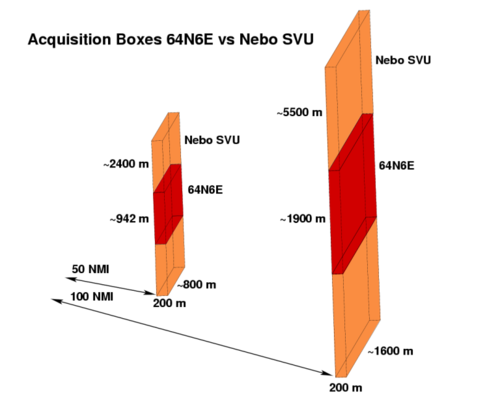
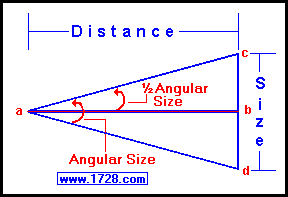
I am going to use the R-77 air to air missile’s radar beam to cover the VHF acquisition box of the Nebo-SVU from 100 nautical miles away. In order for the 9B-1103M2 host radar to get the 1.6km length covered for the .003m2 target from 2kms away would need a 44 degree beam azimuth. The elevation angle to cover the 5.5km height from 2kms away for the .003m2 target would need to be 108 degrees.
Since the 9m96E2 or 40N6 come with active host radars. I have heard the Container radar that came out in 2014 and was upgraded in 2018 can monitor 5000 targets and simply watch aircraft fly off runways and that a certain photonic satellite has a Thz locator offers a smaller than 10cm SAR resolution has the ability to monitor low altitude targets, easily classify cruise missiles or aircrafts and for civilian purposes offer the safety of airplane traffic to a whole new level. For a 90 degree sector scan VHF can get 1 second updates
So can information from OTH radars and satellites be given to command centers for air defense units, and if so can 2 separate data sources be fed through a kelman filter or sensor fusion to offer more accurate data of aerial targets to these air defense units?
Because I am thinking it might be a good idea for air defense operators to know what kind of target is heading their way, how far that target is from them, what altitudes they are at, what direction it will change and its speed, use VHF than fire a missile with a host radar to cover that VHF acquisition box than engage the target. For example the air defense operators already have information beforehand what target it was classified as through satellites along with monitoring its movements through 2 different sources(satellites and OTH radars) and taking into account that your aircrafts or airliners are not in the way would this be a good idea in theory?
When S-400 was first marketed, over a decade ago now, it was usually cited that the entire system, with all options, can guide up to 72 missiles to up to 36 targets. That whole system referred to the option of using six 98ZH6E fire units, each with own targeting radar (92N2). Indeed, even today the rosoboronexport catalogue offers only those figures - up to 36 targets, for the 6 fire units package of the export variant.
But since then, over the years, there have been claims that actual number of targets attacked is higher. Sadly, I can't find a single good source on any of them.
If there's anyone who can provide a half-decent source for a higher number, i'd be very grateful.
Hell, even if someone doesn't have a source but can mount a good argument on why a specific number he lists is the likely number - I will listen to that too.
Finally, If someone can explain how the sometimes cited figure of 160 missiles guided to 80 targets came to be - I'd like to hear that too. Because that figure doesn't make any sense, as long as we're still talking about 6 fire units limit. 80 divided by 6 radars is 13.3333, so that doesn't add up. If there's been an increase in the number of fire units to 8 or 10 - then sure. But if so, is there's a decent source stating that change occurred? Again, one can read on the internet that some change did occur in 2012, leading to both more units and more guidance channels per radar, but is there a decent source to confirm any of that?
But since then, over the years, there have been claims that actual number of targets attacked is higher. Sadly, I can't find a single good source on any of them.
If there's anyone who can provide a half-decent source for a higher number, i'd be very grateful.
Hell, even if someone doesn't have a source but can mount a good argument on why a specific number he lists is the likely number - I will listen to that too.
Finally, If someone can explain how the sometimes cited figure of 160 missiles guided to 80 targets came to be - I'd like to hear that too. Because that figure doesn't make any sense, as long as we're still talking about 6 fire units limit. 80 divided by 6 radars is 13.3333, so that doesn't add up. If there's been an increase in the number of fire units to 8 or 10 - then sure. But if so, is there's a decent source stating that change occurred? Again, one can read on the internet that some change did occur in 2012, leading to both more units and more guidance channels per radar, but is there a decent source to confirm any of that?
panzerfeist1
ACCESS: Secret
Турция раскрыла результаты испытаний С-400: "Триумф" обнаружил истребитель F-16 за 600 километров. Видео
Турция раскрыла фантастические возможности С-400 после тестирования

How Turkey Rigorously Tested its New S-400 Missile System - Capabilities Exceeded Military’s Expectations
In the final week of November 2019 Turkey’s armed forces began testing the capabilities of the recently delivered S-400 surface to air missile’s advanced sensors,
Last edited:
I dont understand. Nothing in those two texts seems pertinent to the question i posed.
Also, not so related, how does one test radar range against f16 out to 600 km away? Rarad would either have to be a kilometer higher than the plane or a very light f16 would have to be performing a zooming maneuver going vertical for a very short stay up at 20 km altitude.
Anyway, its very hard to get proper sources on s400. Those two articles are again far from being a proper source.
Its weird that both eads and cpmiec (for sampt and fd2000) did publish bRochures where their targeting limits were stated.
Also, not so related, how does one test radar range against f16 out to 600 km away? Rarad would either have to be a kilometer higher than the plane or a very light f16 would have to be performing a zooming maneuver going vertical for a very short stay up at 20 km altitude.
Anyway, its very hard to get proper sources on s400. Those two articles are again far from being a proper source.
Its weird that both eads and cpmiec (for sampt and fd2000) did publish bRochures where their targeting limits were stated.
Last edited:
S-400 has 96L6 radar which is installed on 25 meters mast. Helps with radiohorizont quite well. Problem is - official range for that one is 400km.Also, not so related, how does one test radar range against f16 out to 600 km away? Rarad would either have to be a kilometer higher than the plane or a very light f16 would have to be performing a zooming maneuver going vertical for a very short stay up at 20 km altitude.
But anyways, those articles are indeed very pesky and sources on S-400 (just as on many other tech pieces from Russia) are very shady.
panzerfeist1
ACCESS: Secret
I dont understand. Nothing in those two texts seems pertinent to the question i posed.
Also, not so related, how does one test radar range against f16 out to 600 km away? Rarad would either have to be a kilometer higher than the plane or a very light f16 would have to be performing a zooming maneuver going vertical for a very short stay up at 20 km altitude.
Anyway, its very hard to get proper sources on s400. Those two articles are again far from being a proper source.
Its weird that both eads and cpmiec (for sampt and fd2000) did publish bRochures where their targeting limits were stated.
I posted that just for laughs. However there is another problem if you want to understand for the radar targeting information of the s-400 that stealth fans might view as a forbidden taboo to discuss is this.
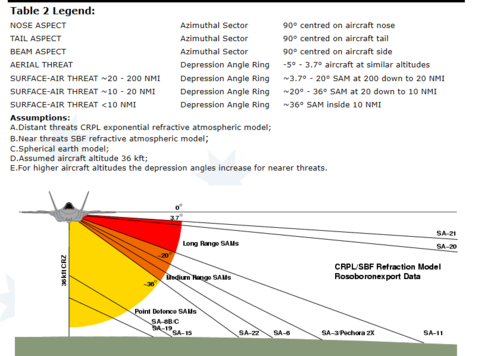
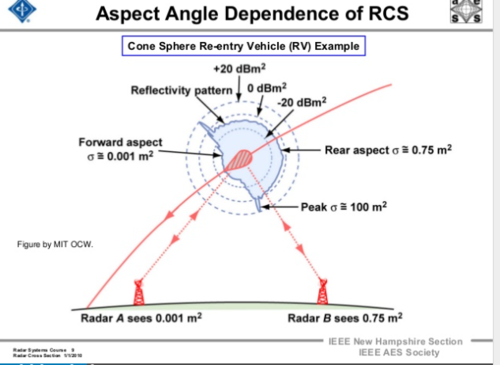
At times it is nice to believe that a ground radar would see nothing but the frontal aspect of the aircraft the entire time, but I am sure that the underbelly of an aircraft would get reflected as well. Sadly I cant find a calculator that would determine the altitudes and distances the radar would point to reflect on the bottom or front side of an aircraft
panzerfeist1
ACCESS: Secret

Russia developing air defense systems based on new physical principles
The weapons based on these principles include laser and microwave guns, sonic weapons and others
" Russia is developing air defense systems based on new physical principles, Air Defense Force Chief Lieutenant-General Alexander Leonov said on Wednesday.
"Eventually, there are plans to arm air defense troops with systems based on new physical principles, which are currently being developed," the general said in an interview with the Defense Ministry’s Krasnaya Zvezda newspaper.
New physical principles are a notional term used to underline that the weapon’s destructive factors are based on processes and phenomena that were not earlier applied for military purposes. The weapons based on these principles include laser and microwave guns, sonic weapons, electromagnetic bombs and others."
Another question, different from the last. Though still has relevance to limits...
Does anyone have a publication/sales brochure/quote from an official (or something to that extent) which discloses the maximum distance (or a least a typical operating distance) the TELs can be placed from the engagement radar in any given battery? I found some pretty official data on Patriot, distance being 30 km, so I'm surprised that the S-400, which has much more data on its export variant out there, seems to have that piece of data hidden and not mentioned anywhere...
Does anyone have a publication/sales brochure/quote from an official (or something to that extent) which discloses the maximum distance (or a least a typical operating distance) the TELs can be placed from the engagement radar in any given battery? I found some pretty official data on Patriot, distance being 30 km, so I'm surprised that the S-400, which has much more data on its export variant out there, seems to have that piece of data hidden and not mentioned anywhere...
- Joined
- 11 February 2010
- Messages
- 1,641
- Reaction score
- 2,677
Another question, different from the last. Though still has relevance to limits...
Does anyone have a publication/sales brochure/quote from an official (or something to that extent) which discloses the maximum distance (or a least a typical operating distance) the TELs can be placed from the engagement radar in any given battery? I found some pretty official data on Patriot, distance being 30 km, so I'm surprised that the S-400, which has much more data on its export variant out there, seems to have that piece of data hidden and not mentioned anywhere...
It's probably not available. Or in follows of old Soviet practices like in Krug (SA-4 Ganef) Where it would be about 5 Km at most the distance between ISR component to battery and 220m distance between engagement radar and the launcher. Soviet practice however involve tight emmission security where connection between SAM components are made by cable.
Should long range connection to be made it would be made via separate system like Troposcatter. As seen in Chinese S-300PMU-2's.
Only Vityaz so far appears to have a dedicated datalink mast as Patriot.
--------
Finally, If someone can explain how the sometimes cited figure of 160 missiles guided to 80 targets came to be - I'd like to hear that too. Because that figure doesn't make any sense, as long as we're still talking about 6 fire units limit. 80 divided by 6 radars is 13.3333, so that doesn't add up. If there's been an increase in the number of fire units to 8 or 10 - then sure. But if so, is there's a decent source stating that change occurred? Again, one can read on the internet that some change did occur in 2012, leading to both more units and more guidance channels per radar, but is there a decent source to confirm any of that?
Have you got this brochure ? This is where the numbers came from.
Attachments
I don't know if that was a reply to my questions, but if it was, I've only got more questions. The link leads to a blog of some sort, which has the usual text on s400. With link to russian edition of wikipedia as source. And then when one does check out the wiki page, 4 more sources are listed. One of those links doesn't work and the three other ones don't seem like official sources at all. And not one of them actually says anything about target limits.
also, no part of that text says anything about datalink distance.
Have you got this brochure ? This is where the numbers came from.
Thanks for that link. I do wish that was rosoboronexport or almaz brochure, because that would've settled it. This way, being produced by Trishul, without stating further sources they used, I can't be sure of its authenticity.
Which also a shame because it does seem to also have some opinion on the datalink range issue as well. There's this page:

And it seems as if there's the answer there somewhere, but with all those different designations of subsystems, i am not sure i'm looking at the right thing. Is it the TCS 31Yu6ME the subsystem i should be looking at? Though that has 6/8 connections. There's 93 Ya6 05 with 12 connections but i'm not sure what that is either. Anyway, it does seem plausible that the 12 launcher option is not necessarily the option that can operate all 12 launchers at great remote distances?
Anyway, all the above would still kind of be a moot point if the data in those brochures can't be linked to something more credible than a Trishul produced document. Sometimes he/they retain the whole document with the margins, so the original source is visible, but in this case there's no margins visible on those scanned papers.
- Joined
- 11 February 2010
- Messages
- 1,641
- Reaction score
- 2,677
Thanks for that link. I do wish that was rosoboronexport or almaz brochure, because that would've settled it. This way, being produced by Trishul, without stating further sources they used, I can't be sure of its authenticity.
Which also a shame because it does seem to also have some opinion on the datalink range issue as well. There's this page:

And it seems as if there's the answer there somewhere, but with all those different designations of subsystems, i am not sure i'm looking at the right thing. Is it the TCS 31Yu6ME the subsystem i should be looking at? Though that has 6/8 connections. There's 93 Ya6 05 with 12 connections but i'm not sure what that is either. Anyway, it does seem plausible that the 12 launcher option is not necessarily the option that can operate all 12 launchers at great remote distances?
Anyway, all the above would still kind of be a moot point if the data in those brochures can't be linked to something more credible than a Trishul produced document. Sometimes he/they retain the whole document with the margins, so the original source is visible, but in this case there's no margins visible on those scanned papers.
Well those looks authentic enough for me. I assume it was a real S-400 brochure and from an exhibition event, it is more recent than what was available. It is not by any means "produced". They may put watermark in the brochure just for sake of pointing readers to their blog. The technical informations there looks pretty real and way too detailed for anyone there to "fudge" it.
So it is now a either you take it or you have actually need to work on the detail yourself. Calculating the performance of the system. The dimension of the radar can be easily found by looking at the chassis. After estimating the array size, you can later work on gain, then assume the amount of power emitted then other parameters. You can then work on tracking capacity with method you could find in book like "Multifunction Array Radar, System Design and Analysis" by S.Sabatini and M. Tarantino. Work on the number then present the result here for us to discuss.
There is unfortunately no other alternative.
- Joined
- 24 January 2006
- Messages
- 1,321
- Reaction score
- 466
The Almaz-Antey catalog gives the 80/160 figure - 8 batteries per complex, ten targets per battery, two missiles per target.
I've seen a figure of 100 m for the distance a 5P85S from an S-300PS can reside from the engagement radar.
I've seen a figure of 100 m for the distance a 5P85S from an S-300PS can reside from the engagement radar.
I really tried to find a pdf document or a photo of such a catalogue but to no avail. Could you provide a link to a such resource?
I find it frustrating that there's a possibility two proper sources would have conflicting info about such a thing. Rosoboronexport catalogue on S400 claims 6 targets attacked and if Almaz catalogue indeed claims 10 then one of those is obviously wrong.
I find it frustrating that there's a possibility two proper sources would have conflicting info about such a thing. Rosoboronexport catalogue on S400 claims 6 targets attacked and if Almaz catalogue indeed claims 10 then one of those is obviously wrong.
- Joined
- 27 December 2005
- Messages
- 17,707
- Reaction score
- 26,148
"Up to 10" and "6" are not necessarily conflicting information. If we imagine that the multitarget capability varies from a minimum of 6 to a maximum of 10 (dependent on mode/sector coverage for example) then both figures could be correct at once, with one brochure emphasising the minimum and the other the maximum. In any case, we are talking theoretical limits here.
In fact, use of "up to 10" practically guarantees some modes or situations do not support 10 target engagement, or why bother with the "up to" qualifier?
In fact, use of "up to 10" practically guarantees some modes or situations do not support 10 target engagement, or why bother with the "up to" qualifier?
"Up to 10" and "6" are not necessarily conflicting information. If we imagine that the multitarget capability varies from a minimum of 6 to a maximum of 10 (dependent on mode/sector coverage for example) then both figures could be correct at once, with one brochure emphasising the minimum and the other the maximum. In any case, we are talking theoretical limits here.
In fact, use of "up to 10" practically guarantees some modes or situations do not support 10 target engagement, or why bother with the "up to" qualifier?
Do you too have access to a pdf/photo of that Almaz catalogue, which you could share?
SOC didn't mention it was stated "up to 10" in the catalogue but even if it was, that wouldn't have to mean much. If there's one target flying - momentary capacity of the system used would be 1. Even if it could in theory go up to 6 or up to 10, depending on sources.
I'd just like to get my hands on such a resource to settle that issue once and for all.
If the limit has indeed gone up to 10, I would imagine one of the possibilities why that limit has increased is the new missiles. If the new missiles have satellite navigation for determining own location and active radars for autonomous terminal guidance - then the engagement radar would have to "waste" less resources guiding its missiles to the targets. Meaning more resources free for engaging additional targets.
panzerfeist1
ACCESS: Secret
MOSCOW, January 20. /TASS/. More than 120 surface-to-air guided missile have been supplied by Russia to Turkey along with a regiment set of S-400 air defense missile systems, a military diplomatic source told TASS on Monday.
"Turkey has received two S-400 battalions, more than 120 surface-to-air missiles, as well as auxiliary equipment, spare parts and tools," the source said, adding that technology transfer, even partial, was not envisaged by the contract.
According to the source, the delivery and acceptance act was signed by the Turkish and Russian sides in Ankara in early December, giving the start to a 20-month warranty maintenance period.
panzerfeist1
ACCESS: Secret
Just some information on what the s-400 can use and some details about its targeting.
https://www.quora.com/Can-the-S-400-shoot-down-a-US-F-22-F-35-or-B-2/answer/Jeff-Jaworski-1/ or just click my profile link.
https://www.quora.com/Can-the-S-400-shoot-down-a-US-F-22-F-35-or-B-2/answer/Jeff-Jaworski-1/ or just click my profile link.
- Joined
- 11 February 2010
- Messages
- 1,641
- Reaction score
- 2,677
Thanks a bunch on that catalogue screenshot!
Problem solved i guess ? Finally with Official Almaz antey logo.
QuadroFX
Russia, Chelyabinsk
Actual for export version of course 
- Joined
- 9 October 2009
- Messages
- 21,928
- Reaction score
- 13,550
Coronavirus puts missile showdown between Turkey and U.S. on hold
Turkey's plans to switch on its new Russian missile defence systems have been delayed by the coronavirus outbreak but it does not intend to reverse a decision which has raised the threat of U.S. sanctions, a senior Turkish official said.
Similar threads
-
-
-
Soviet/Russian long range sam projects
- Started by World B4
- Replies: 0
-
-

